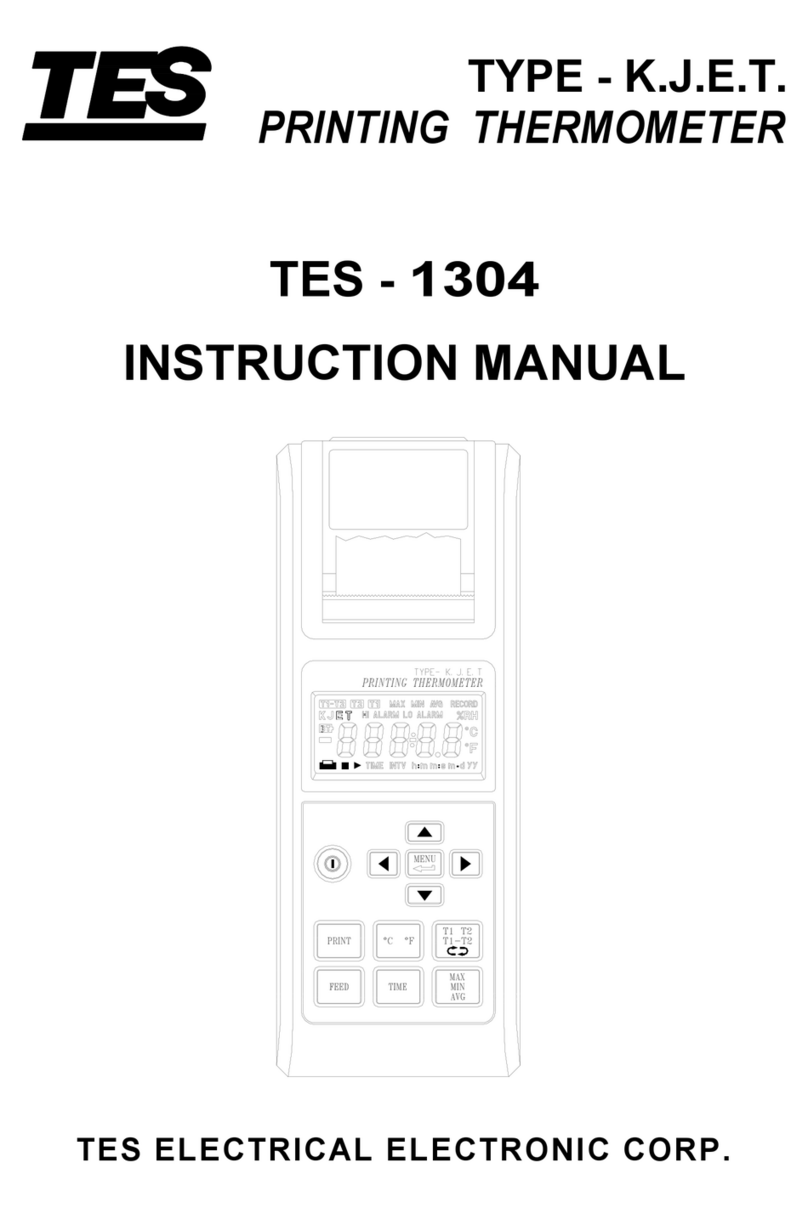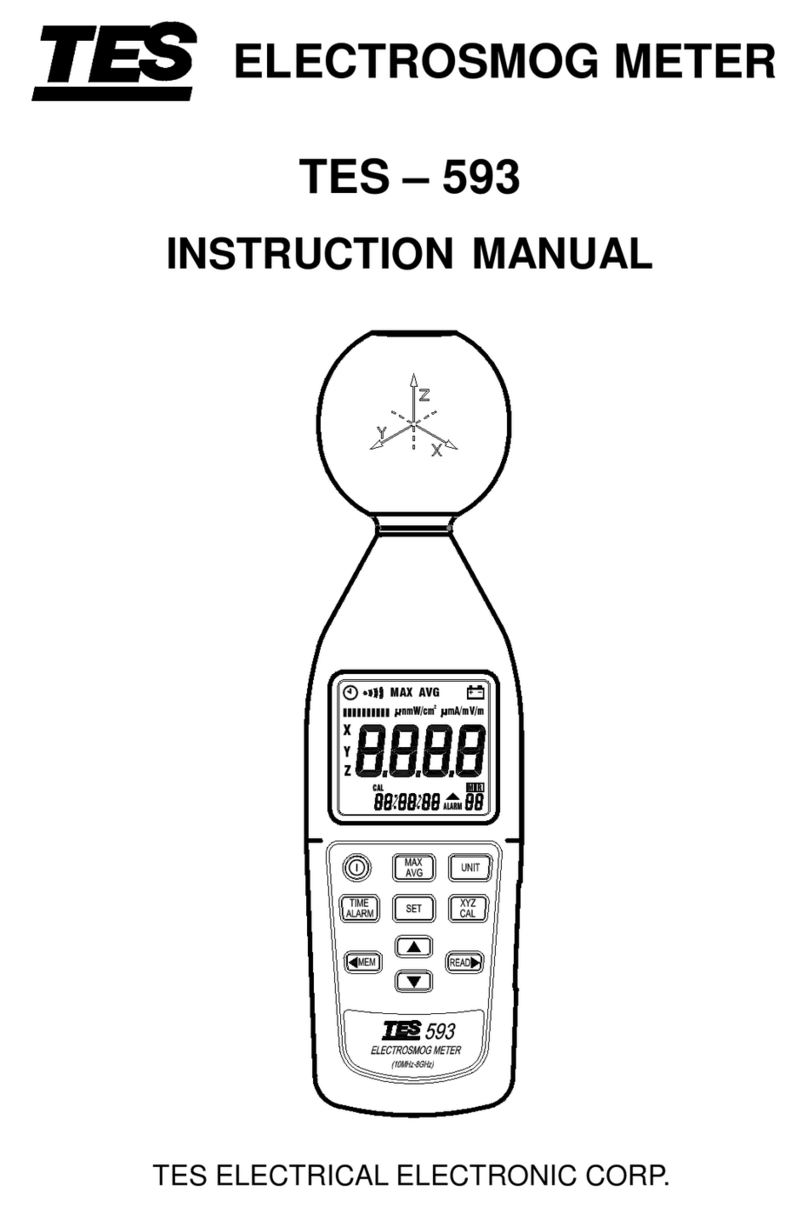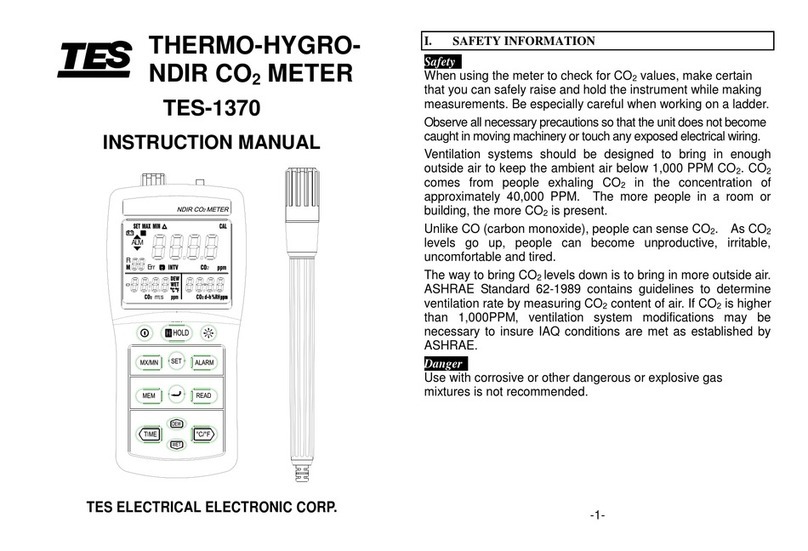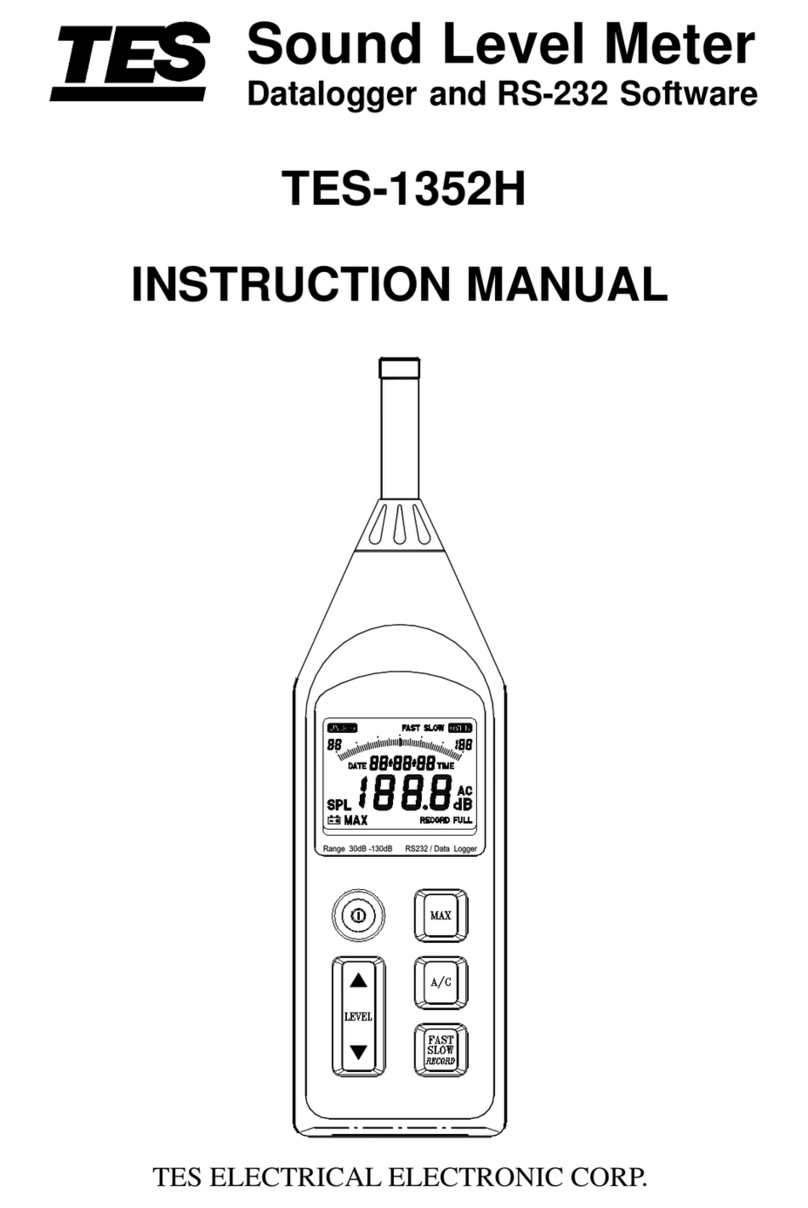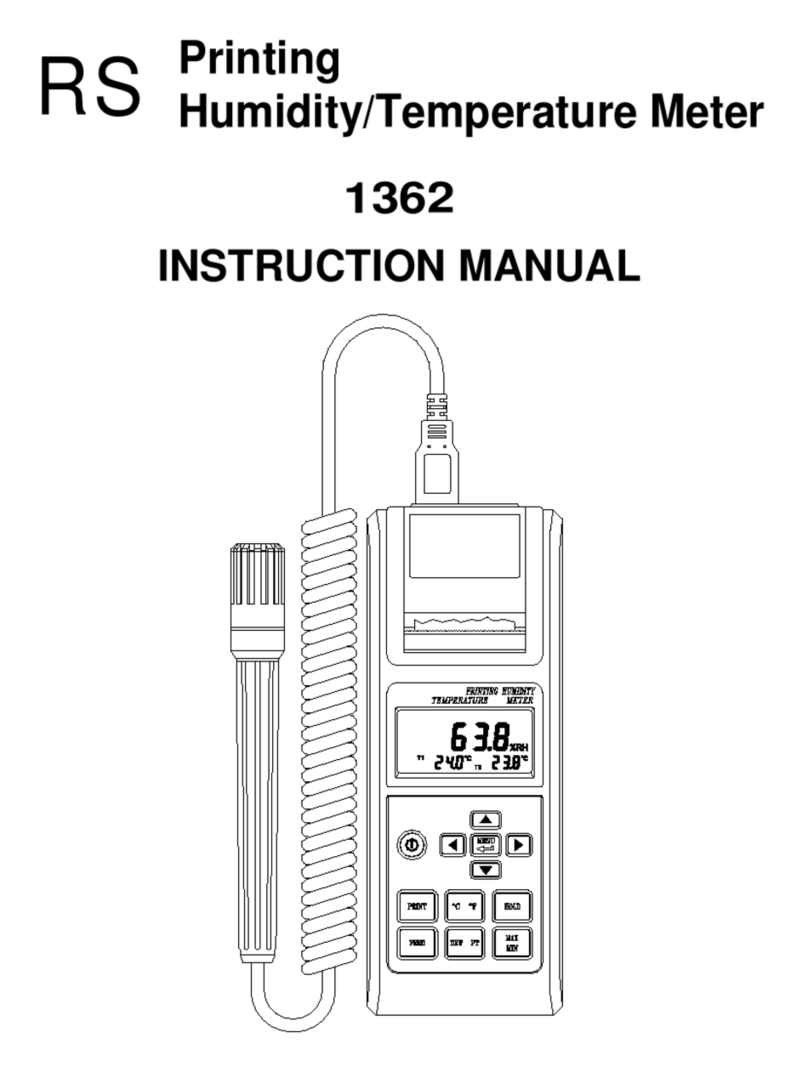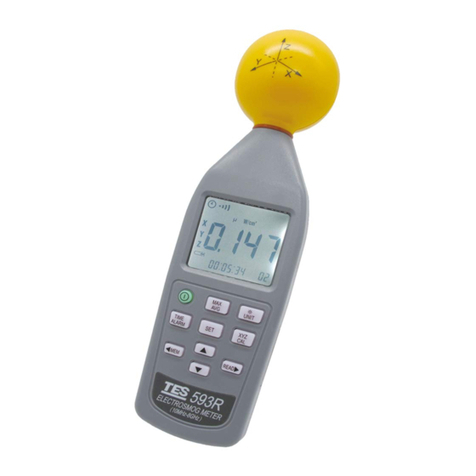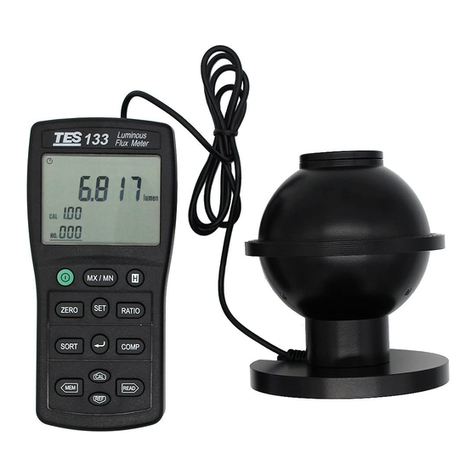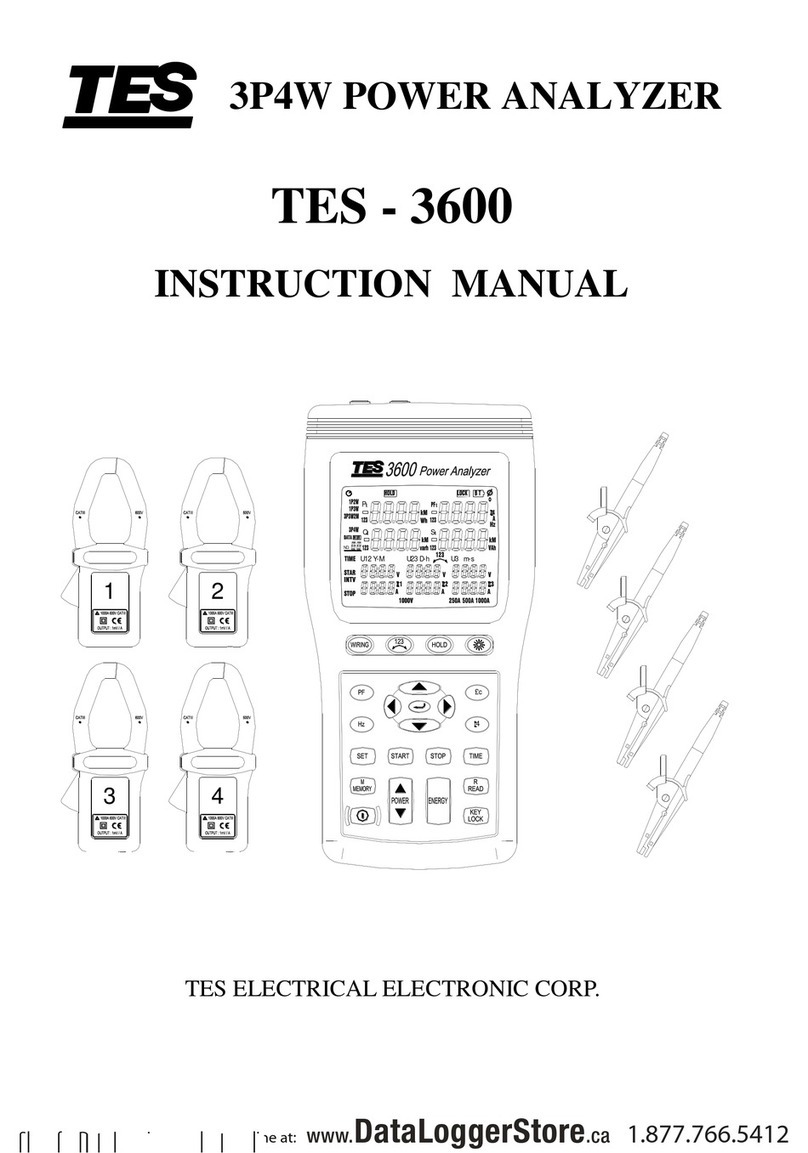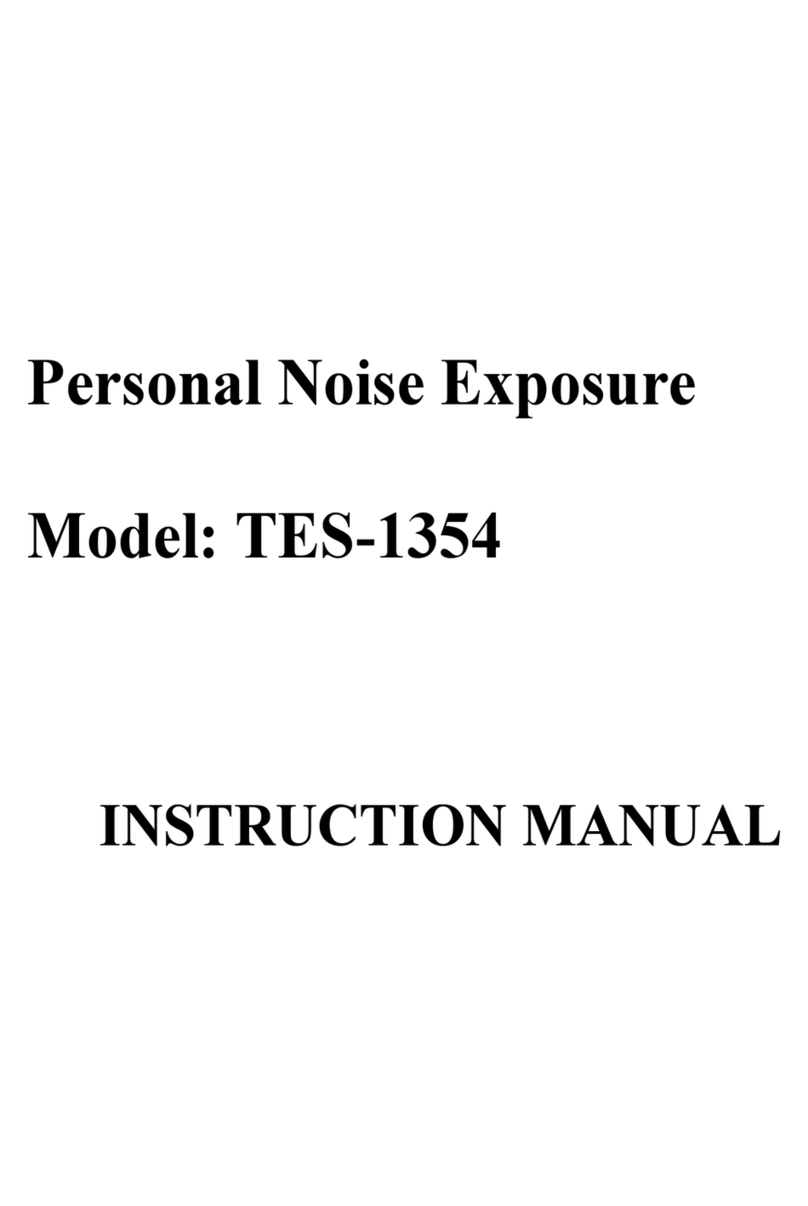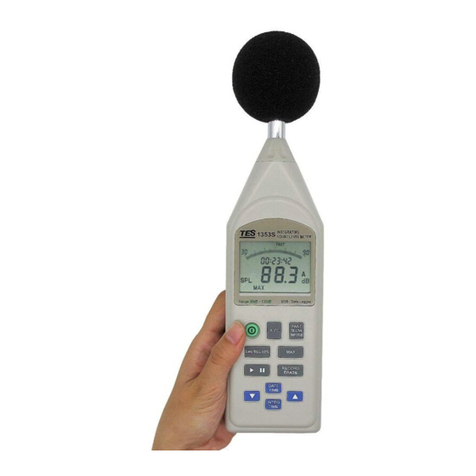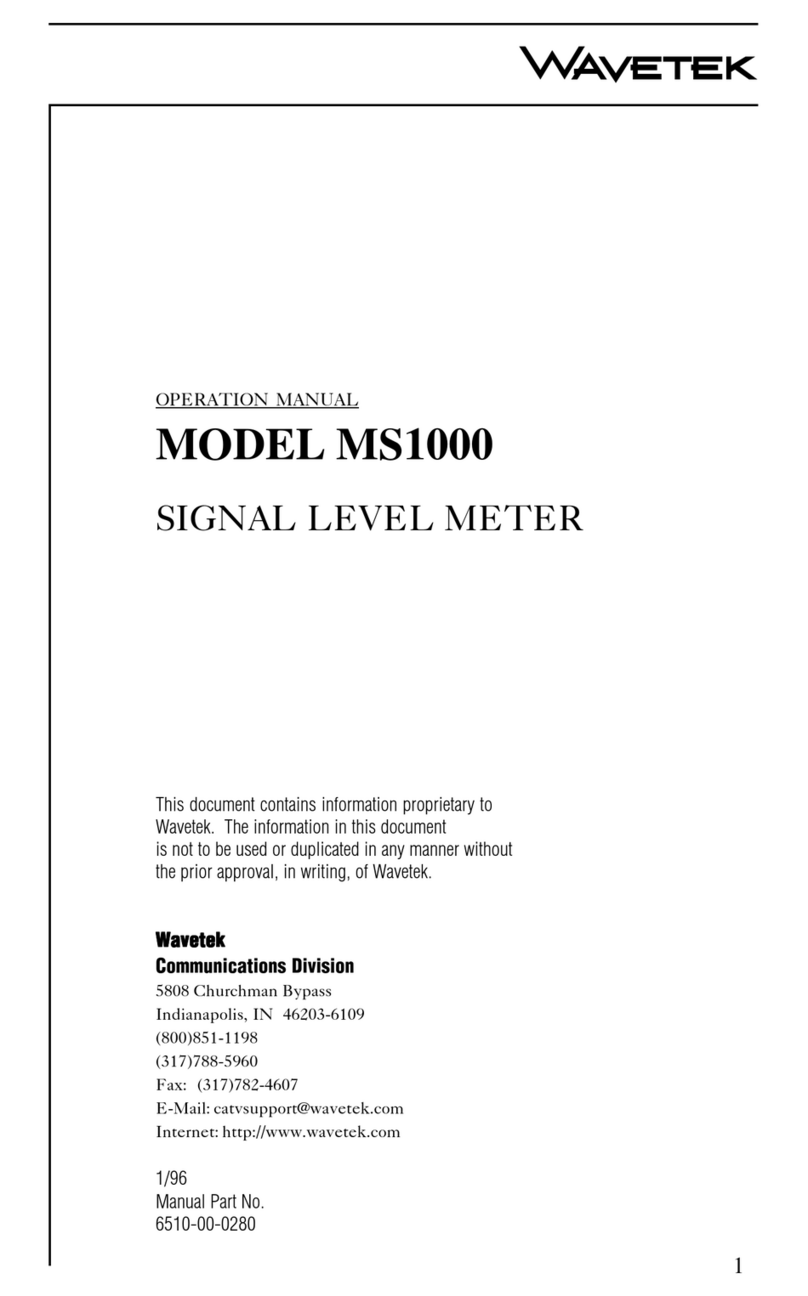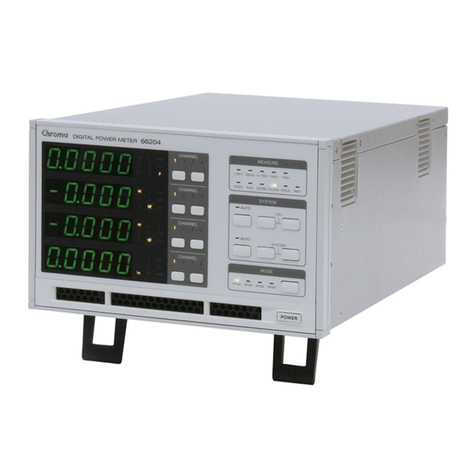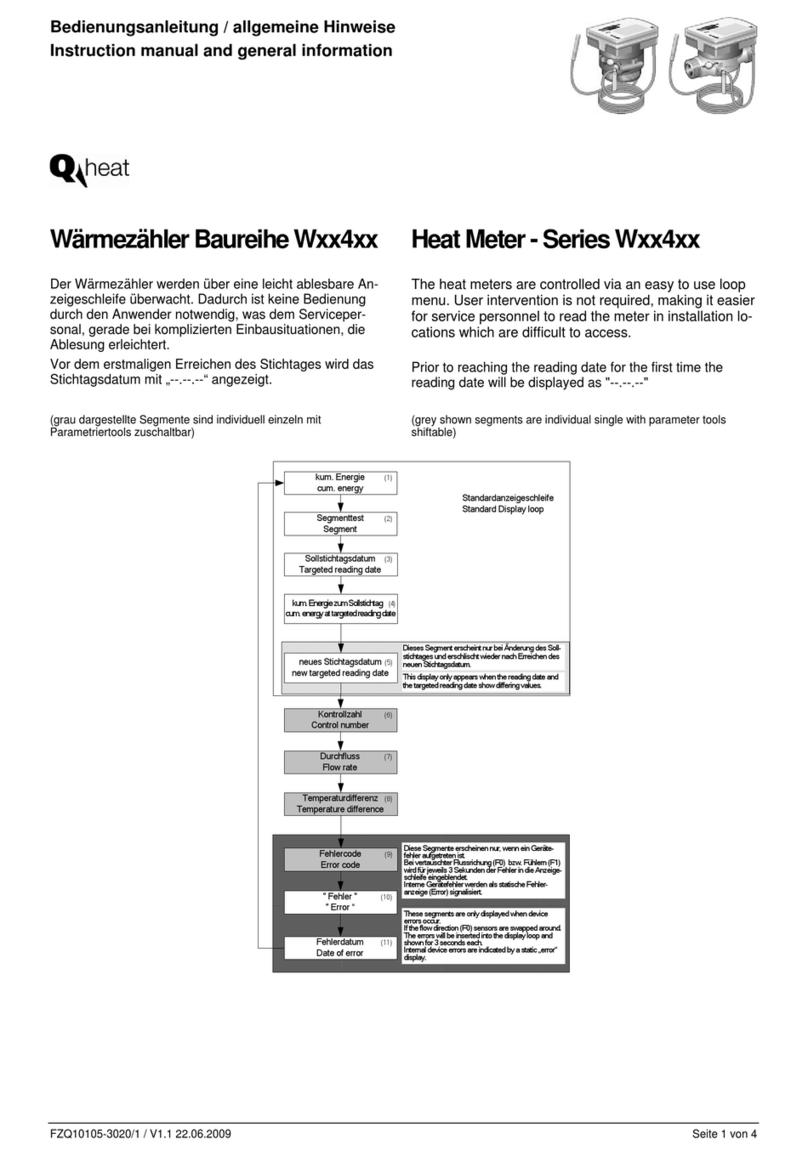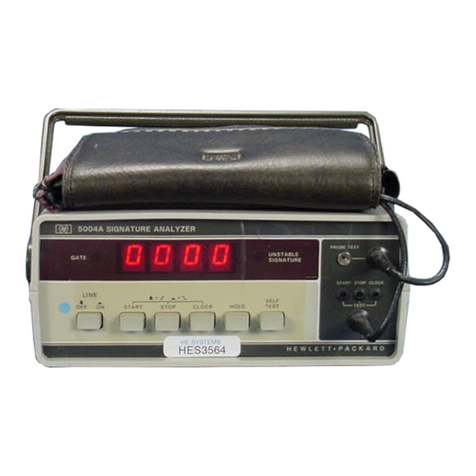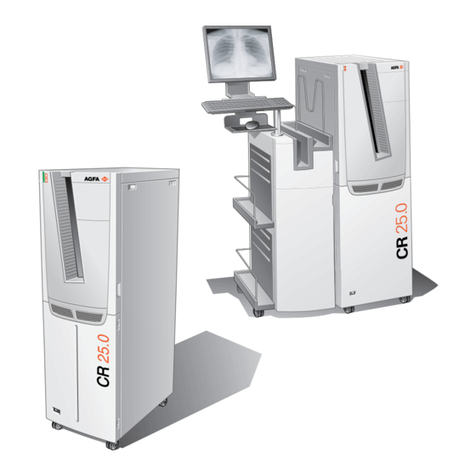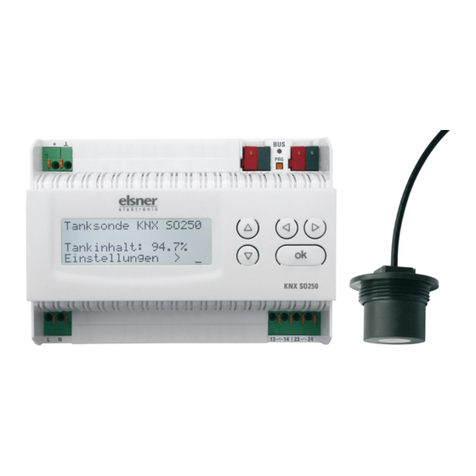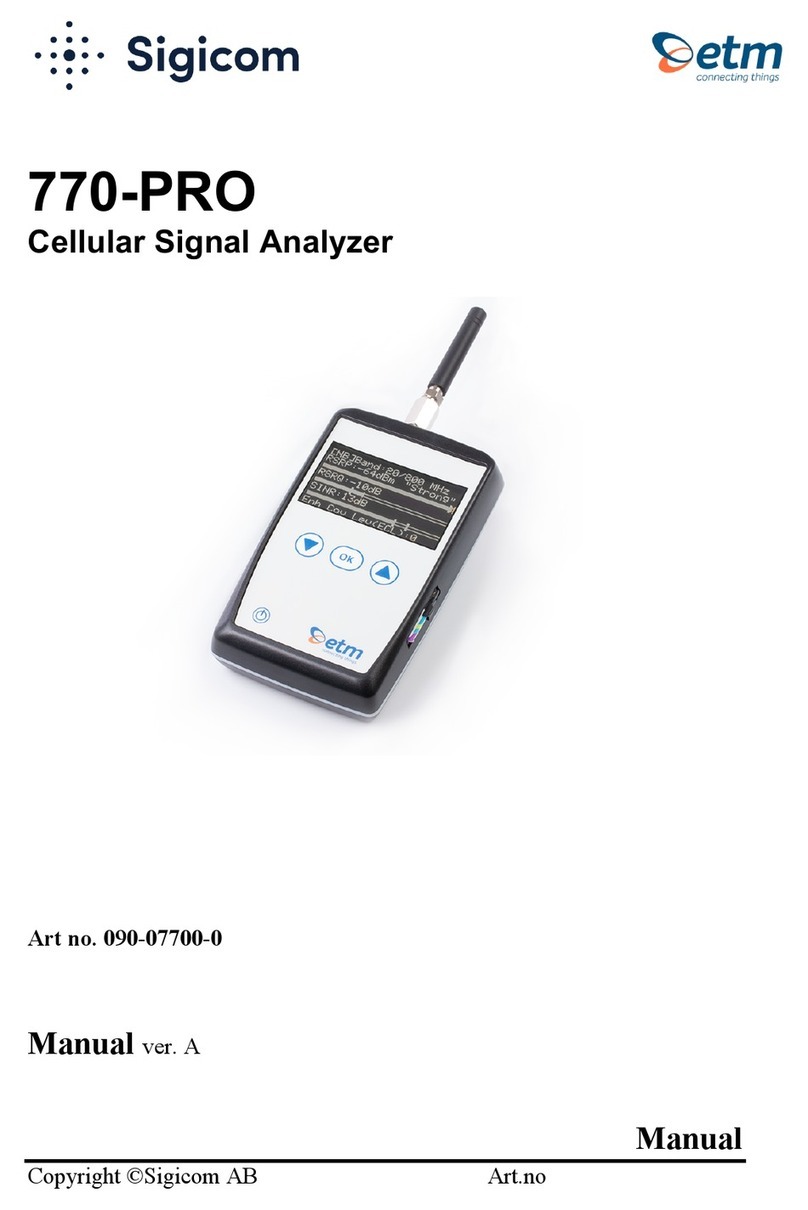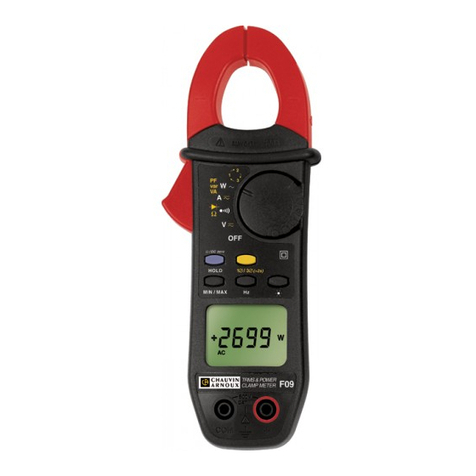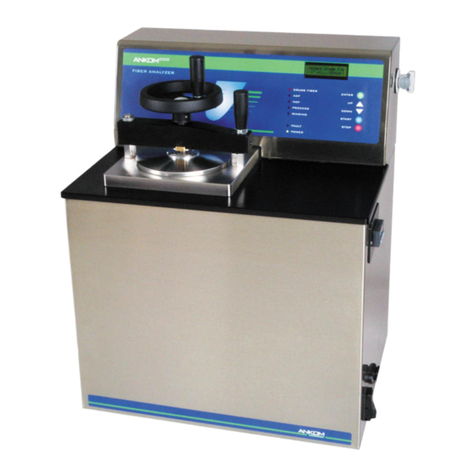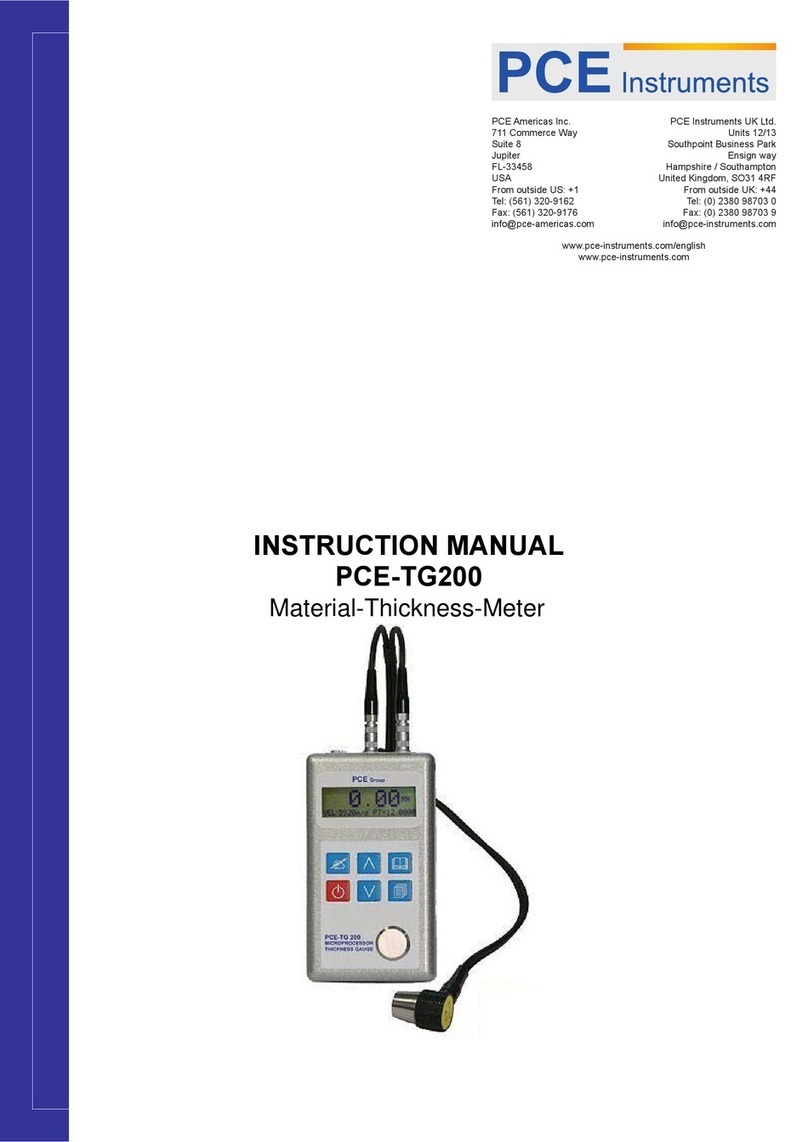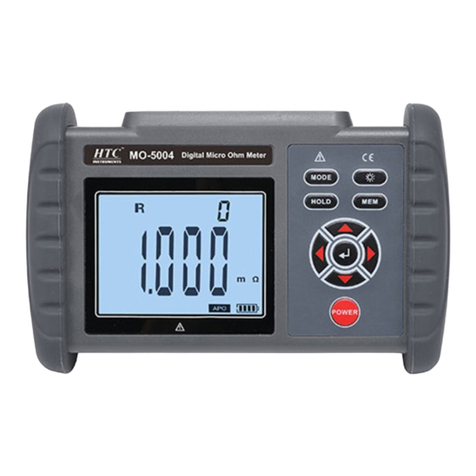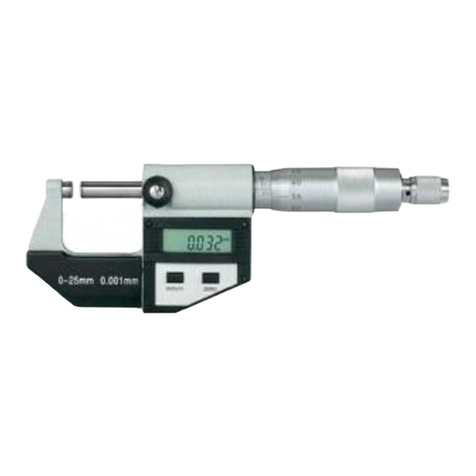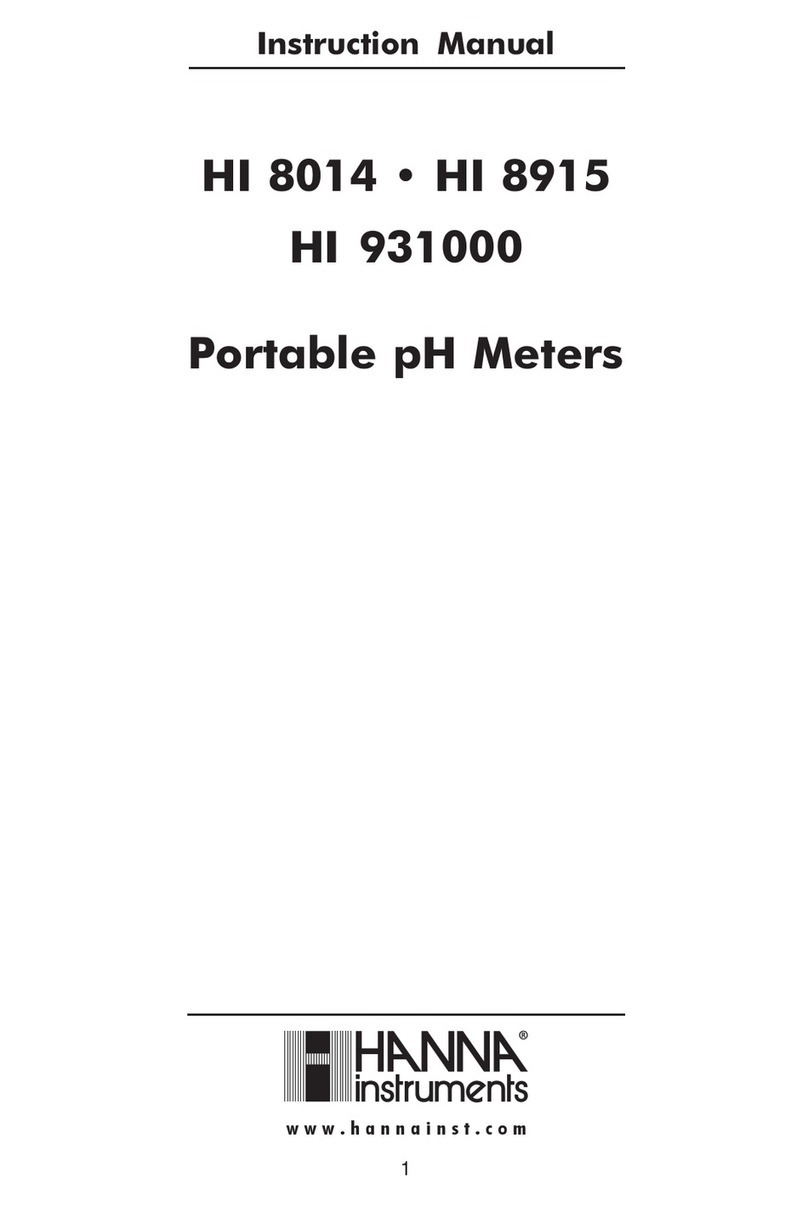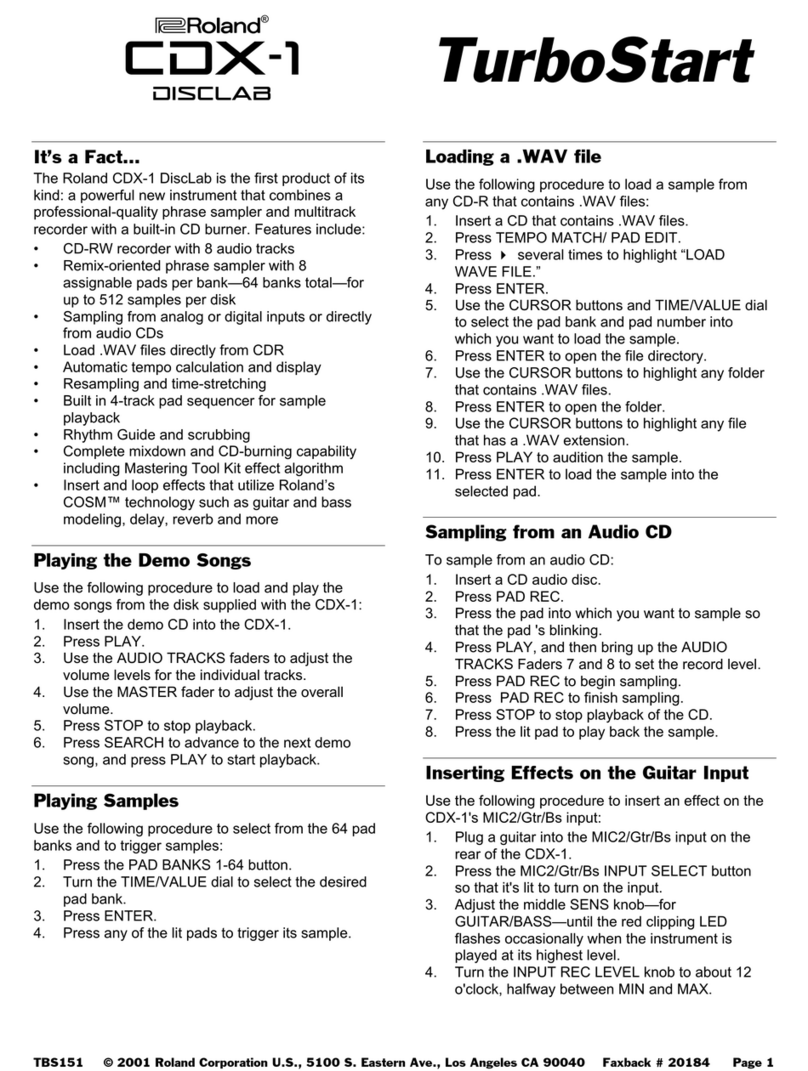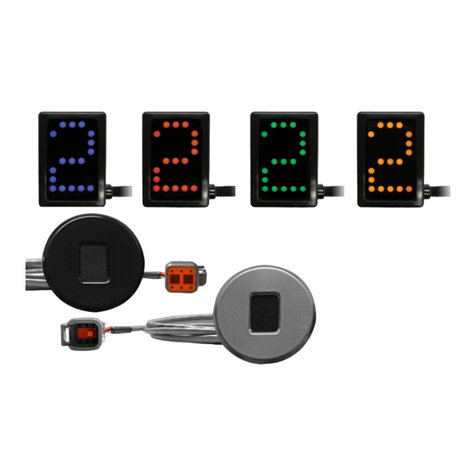TES TES-1358 User manual

Sonómetro Analizador Octavas de Banda, Tipo 1, TES
TE-1358E

Sound Analyzer
Real Time 1/1 & 1/3 Octave band Analysis
TES-1358
INSTRUCTION MANUAL
[ 1 / 3 OCT ] 01 / 07 / 27
14:26:39
100
W
A
L
Hz
125
30
50
31.5
500
70
90
dB
FAST
75.2 dB
8k
2k
L
W
80
60
40
TES ELECTRICAL ELECTRONIC CORP.

CONTENTS
Title Page
I. SAFETY INFORMATION.....................................................1
II. GENERAL & FEATURES....................................................2
III. SPECIFICATIONS...............................................................2
IV. CONTROLS AND FUNCTIONS..........................................5
4-1Partsdescription............................................................................5
4-2 Operation keys...............................................................................7
4-3 Measurement screen...................................................................10
V. CALIBRATION PROCEDURES........................................ 11
VI. MEASUREMENT PREPARATION....................................12
VII. SETTING THE DATE AND TIME ......................................12
VIII. SOUND PRESSURE LEVEL MEASUREMENT................13
8-1Technicalnotes............................................................................13
8-2 Instantaneous sound pressure level measurement (LA, LC, LP).14
8-3 Leq and LEmeasurement.............................................................16
IX. MEMORY FUNCTION .......................................................18
9-1 Manual storing data in memory (1024 data sets).......................18
9-2 Reading from memory.................................................................20
9-3Auto storingdata in memory........................................................21
9-4 Erasememory data.....................................................................23
X. RS-232 INTERFACE, SOFTWARE INSTALLATION and
OPERATION......................................................................23

1
I. SAFETY INFORMATION
Read the following safety information carefully before
attempting to operate or service the meter.
Use the meter only as specified in this manual; otherwise, the
protection provided by the meter may be impaired.
Environment conditions
Altitude up to 2000 meters
Relative humidity 90% max.
Operation Ambient 0 ~40℃
Maintenance & Clearing
Repairs or servicing not covered in this manual should
only be performed by qualified personnel.
Periodically wipe the case with a dry cloth. Do not use
abrasives or solvents on this instrument.
Safety symbols
Comply with EMC

2
II. GENERAL & FEATURES
The sound analyzer meter allows digital 1/1-octave and
1/3-octave analysis in real time.
Five measured parameters SPL (Sound Pressure Level), Leq
(Equivalent Continuous Sound Pressure Level), LE (Sound
Exposure Level), Lmax (Maximum Sound Pressure Level),
Lmin (Minimum Sound Pressure Level)
RS-232 interface with PC.
Data Logger function.
Real time clock with calendar.
Both AC and DC signals output is available for level recorder,
graphic recorder.
Auto-Ranging for SPL function.
III.SPECIFICATIONS
Standard applied : IEC 60651 type2, 60804 type 2, ANSI S1.4
type2, IEC 1260 (1995).
Display : Backlit LCD, 160×160 dots.
Sound level meter mode
Numeric display : 4 digits, update rate 0.5S,
resolution 0.1 dB.
Bar graph display :100dB range, update rate
0.125S, resolution 1dB.
Frequency analysis mode
Numeric display : 4 digits, update rate 0.5S,
resolution 0.1dB.
Bar graph display : 70dB range, update rate
0.125S, resolution 1 dB.

3
Accuracy :
±1.5dB (ref 94dB @1kHz)
Measurement Frequency range : 25Hz
–
10KHz
Dynamic range : 100dB (Sound level meter mode)
70dB (Frequency analysis mode)
Measurement range : 30dB –130dB
Sound Pressure Level range:
Sound level meter mode (display range 100dB) :
30 –130dB
Frequency analysis mode (display range 70dB) :
20–90dB, 30–100dB, 40–110dB, 50–120dB, 60–130dB
Frequency weighting : A, C, P (Flat)
Time weighting : Fast, Slow
Microphone : 1/2 inch electret condenser microphone.
Display warning indicator :
OVER indicator (Input signal over the upper limit)
UNDER indicator (Input signal under the lower limit)
Warm-up time : Less than 20min
Memory capacity : Manual store block and auto store block
(separate).
Store mode
Mode
Manual
Auto
Sound level meter
1024 data sets
10000 data sets
1/1-octave analysis
1024 data sets
6140 data sets
1/3-octave analysis
1024 data sets
3070 data sets

4
AC output : 2 Vrms at FS (full scale).
output impedance approx. 600Ω.
DC output : 10mV/dB.
output impedance approx. 100Ω.
Power : 4 pcs of C size 1.5V (LR14) alkaline batteries.
External DC power supply : 6 Vdc, 1A.
Battery life : Approx. 2hours
Operating Temperature/Humidity : 0℃to +40℃,10 to 90%RH.
Storage Temperature/Humidity : -10℃to +60℃,10 to 75%RH.
(battery removal)
Dimensions & Weight : 34.5(H) ×10(W) × 6(D) cm
Approx.950g (including batteries).
Accessories : Instruction manual, Alkaline battery × 4, Hard
carry case, CD-ROM, RS-232 cable, ( 9 pin to
25 pin gender changer), Adjustment screw
driver, Windscreen, 3.5plug, AC adaptor.
Optional accessories : Microphone extension cable (5m or
10m), Sound level calibrator, Tripod.

5
IV. CONTROLS AND FUNCTIONS
4-1 Parts description
FAST L
2k
[ 1 / 3 OCT ] 01 / 06 / 19 14:26:39
20
40
31.5Hz 500125
60
80
dB
100 A W
W8k L
65.2 dB
IEC 1260 CLASS2
OFF ON
POWER CAL
IEC LR14 1.5V X 4
ACCURACY : ¡ Ó1.5dB
OFF ON
DC AC
CONTRAST
OUTPUT
DC6V LIGHT
SOUND ANALYZER
IEC 651 IEC 804 TYPE 2
1/1 & 1/3 OCTAVE BAND
1. Windscreen
If you operate at wind speed over 10m/sec. Please put
windscreen in front of the microphone.
2. Microphone
The microphone assembly can be removed from the sound
level meter and connected via an optional extension cable, for
measurements a distance.

6
3. Display
The backlit liquid crystal display has a resolution of 160×160
dots.
4. Operation keys
5. Power switch
This sliding switch serves to turn the unit on and off.
6. Calibration adjust knob
Serves to carry out calibration, using the supplied adjustment
screwdriver.
7. DC 6V jack
The AC adaptor can be plug here for powering the unit from an
AC outlet for long term measurements.
8. DC output jack
A DC signal corresponding to the sound pressure level is
available at this output.
9. AC output jack
AAC signal corresponding to the sound pressure is available
at this output.
10.LCD contrast adjust knob
Serves to adjust the display contrast. Use the supplied
adjustment screwdriver for the adjustment.
11.LCD backlight switch
Serves to turn the display backlight on and off.
12.Hand strap
The strap should be used to safely carry the unit during field
work.
13.RS-232 interface connector
Serves for input and output of control signals and
measurement data. Acomputer can be connected here.
14.Battery compartment
The unit uses four batteries.
15.Tripod mounting screw
For long term measurements, the unit can be mounted on
the tripod.

7
4-2 Operation keys
a.) MODE key
Serves to call up the various processing results on
the display.
For display items are sound pressure level (L),
equivalent continuous sound pressure level (Leq),
Sound exposure level (L
E
), maximum sound pressure
level (Lmax), and minimum sound pressure level
(Lmin).
b.) FREQ WGHT key
Selects the frequency weighting characteristic.
Available settings are “A” weighting (A), “C” weighting
(C), and flat frequency response (P).
c.) TIME CONST key
Selects the time weighting. Available settings are
“FAST” and “SLOW”.

8
d.)
LEVEL
Servestoselectthesound pressurelevelrangeson1/1and1/3
octavebandfrequencyanalysismode.(20~90dB,30~100dB,
40~110dB,50~120dBand60~130dB,total5ranges)
e.)
SLM/ 1/1/ 1/3 key
This key switches the operation mode between sound
level meter (SLM), 1/1-octave frequency analysis (1/1),
and 1/3-octave frequency analysis (1/3).
f.)
MEAS TIME key
Sets the Leq, LE, Lmax and Lmin measurement time :
24h1s3s10s30s1m5m8m10m15m
30m1h8h
2nd + MEAS TIME : Enter to setting the date
and time mode.
g.) MEMORY key
Enter to memory mode.
2nd + MEMORY : Enter to data record
interval time setting : 0 (no record)
1s 3s10s
30s1m5m8m10m15m30m1h62.5ms
h.) ENTER key
Store the new date and time, the time clock is start.
i.) Cursorkey
Serve to move the octave frequency band marker during
frequency analysis.
2nd+ Cursor: In recall mode to select the
memory address in which to store the measurement
data.
j.) START/STOP key
Press to start and to terminate the Leq, LE, Lmax and Lmin

9
sound pressure level measurement.
k.) PAUSE/CONT key
Server to the measurement temporarily pause ( display)
or resume (display ).
l.) 2nd key
Press to shift key to second function.
m.) STORE key
In manual memory mode, store the measured data into the
memory.
n.) RECALL key
In manual memory mode, recall the stored memory data.
o.) STORE + RECALL key (Erase memory data)
Turn off the meter, press and hold down STORE and
RECALL two keys, then turn on the meter, until the LCD
display “ALL memory are erased”.

10
4-3 Measurement screen
1. Sound pressure level measurement screen
[ SLM ] 01 / 07 / 27 14:26:39
AL
30 80
FAST
dB
130
2. 1/1-octave analysis screen
The staircase shape on the display represents the 1/1-octave
analysis result. From left, the bars correspond to 31.5, 63,
125, 250, 500, 1k, 2k, 4k, 8kHz. To read the levels at these
frequencies, use the Cursorkey to move the cursor to
the desired point. The frequency and level are then shown
on the upper of the screen.
68.4 dB
[ 1 / 1 OCT ] 01 / 07 / 27 14:26:39
50
31.5 125Hz
30 8k2k500
AL
100
dB
70
90
FAST 2k Hz
L W
40
60
80

11
3. 1/3-octave analysis screen
The staircase shape on the display represents the 1/3-octave
analysis result. From left, the bars correspond to 25, 31.5, 40,
50, 63, 80, 100, 125, 160, 200, 250, 315, 400, 500, 630, 800,
1k, 1.25k, 1.6k, 2k, 2.5k, 3.15k, 4k, 5k, 6.3k, 8k, 10kHz. To
read the levels at these frequencies, use the Cursor
key to move the cursor to the desired point. The frequency
and level are then shown on the upper of the screen.
[ 1 / 3 OCT ] 01 / 07/ 27 14:26:39
31.5Hz30
50
70
2k500125 8k L W
A
FAST
90
dB LW 75.2 dB
100
60
80
40
V. CALIBRATION PROCEDURES
Using a standard acoustic calibrator such as the TES-1356.
1. Make the following switch settings.
Display : SLM (LA)
Time weighting : FAST
2. Insert the microphone housing carefully into
the insertion hole of the calibrator.
3. Turn on the switch of calibrator and adjust
the CAL potentiometer of the unit so that the
display indicates the desired level.
Our products are all well calibrated before
shipment.
Recommended recalibration cycle : 1 year.
Caution : Ambient sources of noise or vibration
can cause a false calibration.
[ SLM ] 01/ 06 / 19 14:26:39
FAST
30
AL
80
dB
130

12
VI. MEASUREMENT PREPARATION
1. Battery loading
Remove the battery cover on the back and put in four 1.5V C
size battery.
Note : Take care to observe battery polarity.
2. Battery replacement
When the battery voltage drops below the operation voltage.
LBATT appears and flashes in the display. If it appears the
batteries should be replaced with new batteries.
3. AC adaptor connection
When the AC adaptor is used, insert the plugs of the adaptor
into the DC 6V jack on the side panel.
VII.SETTING THE DATE AND TIME
Date and time information is stored with each record you save.
Therefore, it is important to make sure this information is correct.
Set the date and time as described below :
1. Press 2nd key one time then press MEAS TIME key,
enter to setting the date and time mode.
The display screen in second location will be flicker.
2. Press LEVELkey to set the numbers increase or
decrease.
3. Press Cursorkey, move flicker number location to
year/month/day/hour/minute/second setting location.
4. Press LEVELkey to set the number.
5. When the setting is correct, press ENTER key to exit this
mode and the time clock is start.
Note : When no change the date and time or no press ENTER
key about one minute, will leave setting the date and time
mode, the original setting date and time is no changed.

13
VIII. SOUND PRESSURE LEVEL MEASUREMENT
8-1 Technical notes
1. The decibel (dB)
The range over which the human ear responds to sound
pressure (noise) is extremely large ; 20Pa (the threshold of
hearing) to 100 Pa (the threshold of pain). The measurement
of sound pressure is made manageable by use of the decibel,
which is logarithmic. This is good for ease of reference,
however it means that decibels are not linear and so can not
be added together. A simple rule is that doubling the noise
causes the level to rise by 3dB.
2. SLM-sound level meter
Instantaneous sound pressure level (SPL) is used for spot
checks to establish instantaneous noise levels that might be
of concern and is defined by the logarithmic equation :
SPL (in dB) : 20 log10
0P
P
Where P = rms measured sound pressure level
P0= rms reference sound pressure level (deemed to
be 20Pa)
3. Leq-level equivalent (continuous)
Leq is used to assess the rms average noise level over a
preset period of time, often the starting point of a noise
assessment.
To make an Leq measurement the period of time over which
it is to be made be selected. The longer the period of
measurement, the more accurate the Leq reading, a typical
period used is 8 hours (the length of a working day).
4. LE–Sound exposure level
LEmeasurements are almost identical to Leq measurements
but normalised or compressed in to 1 second. This allows
the total sound energy of an event, such as train passing a

14
platform, to be evaluated. Another event, such as the next
train, which lasts for a different amount of time can be
measured in the same way. The two readings can be
compared to assess how much total noise the passengers
standing at the platform were exposed to by each train. To
make an LEmeasurement either a preset time period must be
selected on the instrument, or the PAUST/CONT key
must be used to stop and start measurement of a specific
event.
8-2 Instantaneous sound pressure level measurement (LA, LC, LP)
To perform a measurement, carry out the following steps.
1. Set the power switch to ON and wait until the measurement
screen appears.
ID No: 00001358 Ver: 0.10
SOUND LEVEL METER
1/1 & 1/3 Octave Band
Real-Time Analyzer
Self-Testing...
[ SLM ] 01 / 07 / 27 14:26:39
AL
30 80
FAST
dB
130
2. Press the SLM/ 1/1/ 1/3 key to select desired SLM, 1/1 or
1/3 octave band sound pressure level measurement screen.

15
70
500
[ 1 / 1 OCT ] 01 / 07 / 27 14:26:39
125Hz 31.5
30
50
8k L W2k
A
FAST L
90
dB 75.2 dBW
40
60
100
80
[ 1 / 3 OCT ] 01 / 07/ 27 14:26:39
31.5Hz30
50
70
2k500125 8k L W
A
FAST
90
dB LW 75.2 dB
100
60
80
40
3. Use the FREQ WGHT key to select the desired LA, LCor
LPfrequency weighting setting.
4. Use the TIME CONST key to select the desired FAST or
SLOW time constant setting. Normally, the “FAST” setting
should be used.
5. Use the LEVELkey to select the level range .
Choose a setting in which the “OVER” and “UNDER”
indications do not appear. In SLM mode, the dynamic range
is 30~130dB, so the LEVELkey is not activate.
[ 1 / 1 OCT ] 01 / 07 / 27 14:26:39
500
70
125Hz 31.5
60
40
30
50
A
FAST L
100
80
90
dB
WL8k2k
75.2 dBW

16
8-3 Leq and LEmeasurement
To perform a measurement, carry out the following steps.
1. Set the power switch to ON and wait until the measurement
screen appears.
2. Press the MEAS TIME key, setting the preset measurement
time for a fixed time period (know as the integral time), after
which measurement automatically stops.
There are 13 preset time settings available :
1s
10min
3s
15min
10s
30min
30s
1h
1min
8h
5min
24h
8min
Note : The setting will wrap around from 24h to 1s.
L
[ 1 / 1 OCT ] 01 / 07 / 27 14:26:39
FAST A W 75.2 dB
100
Hz 31.5 125 500 2k WL8k
dB
90
70
50
30
60
40
80

17
3. Use the SLM/ 1/1/ 1/3 key to select desired SLM, 1/1 or
1/3 octave band sound pressure level measurement screen.
4. Use the FREQ WGHT key to select the desired LA, LC or LP
frequency weighting setting.
5. Use the TIME CONST key to select the desired FAST or
SLOW time constant setting. Normally, the “FAST” setting
should be used.
6. Use the LEVELkey to select the level range.
Choose a setting in which the “OVER” and “UNDER”
indications do not appear. In SLM mode, the dynamic range is
30~130dB, so the LEVELkey is not activate.
7. Press the START/STOP key. The “” mark on the
display and the equivalent continuous sound pressure level
measurement begins.
8. At the any measurement conditions “measuring”, “ pause”
or “■terminate”. Can be use MODE key to select view
the any other parameter L, Leq, LE, Lmax or Lmin measure
value.
9. When the measurement time set in step 2 has elapsed, the
measurement terminate automatically.
10.When wish to terminate the measurement earlier, press the
PAUSE/CONT key to paused measuring, the “”mark will
appear on the display. Press PAUSE/CONT key again will
resume measuring.
11.Press the START/STOP key to stop measuring, the “■”
mark will appear on the display.
12.Press the MODE key to display the LAeq , LAE or other
parameter value.
Note : In this measurement, can not change frequency
weighting, time weighting and SLM/ 1/1/ 1/3 mode.
Table of contents
Other TES Measuring Instrument manuals
